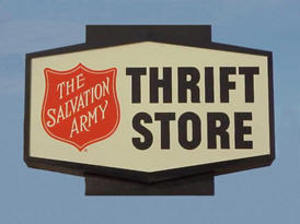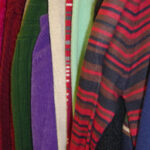Note on ethics: The common question I get is, “Isn’t that taking advantage of the purpose of thrift stores – to help the poor?” In short, no. Thrift stores make money and help people in many ways, one of those is by selling donated goods. Plus, savvy thrift stores like my local Goodwill stores are marking the prices up for higher end, name brand goods. They know an opportunity when they see it, and so should you.
Note on Money: Don’t buy merchandise with the household money if you can avoid it. The best way to get started is to actually sell off a few things of your own first to build up some capital. If you have no experience on eBay, you may want to buy a few (very inexpensive) things to build some positive feedback. Start small and build a good reputation.
Now let’s start making money . . .
This sounds deceptively simple – buy “diamonds in the rough” at your local Salvation Army or Goodwill, then sell it on eBay. How much easier could it be, right?
Wrong… Goodwill, Salvation Army, and other thrift shops have raised their prices in recent years, so your margin may be very skimpy. Resale shop owners have always used this avenue to obtain quality goods at a good price and here’s how they do it. Here’s how to get the most out of thrift store shopping and reselling.
First, Know Your Market.
Go to eBay Pop (http://www.mpire.com/research/ebayPop.ivk) and research what’s really selling. What’s hot right now? What brands are really popular – remember, this isn’t about what you like. It’s about what eBay shoppers like.
While you’re there, check out eBay’s “Want it Now” section and look at the items people are actively wanting to purchase. Make a list of things you think you might be able to find at your local thrift stores and take the list with you when you go shopping.
Don’t forget to cruise Overstock.com, Bluefly.com and other sites to see what the hot sellers are for them too.
Next, Know Your Merchandise
EBay has some wonderful articles and guides about picking out “fake” or “replica” merchandise so you don’t get swindled. Remember, you’re going to be reselling these items, and your reputation is at stake. your buyer won’t care if you thought it was the genuine article when you bought, only that it’s not.
Learn to spot quality. Even if an item has a designer label, that isn’t necessarily an assurance of quality. See if there’s damage. Check inside and outside. If you can do basic repairs, sewing etc., that’s wonderful. But you don’t want to be stuck with merchandise that all needs mending and cleaning. You’ll want things that you can turnaround quickly.
This is why many eBay sellers specialize in only a few things that they know really well. So think about what categories you know a lot about and see how they’re doing on eBay. If music boxes are your thing, take a look to see what music boxes are getting the most money.
Tip: If you use “Advanced Search” you search only “completed listings” to find the most focused information.
Third, Know your Stores
This just takes time. Learn how the stores you frequent are laid out. Go frequently. Learn when and how often they put merchandise out. Learn what items they’re likely to negotiate on – like a shirt with a missing button, a figurine with a small scratch, etc. Generally, I don’t mention what I do because the reaction I’ve gotten in the past has been very mixed.
Fourth, Get the Right Tools.
I highly recommend getting a Jeweler’s Loop. These are very handy not only for looking at Jewelry makers’ marks, but also for reading the tiny print on labels, checking sticking, reading the marks on pottery, and the like. Thrift stores frequently have poor lighting so If a jeweler’s loop isn’t convenient, a high quality magnifying glass will work also.
Tape measure.
Note pad and pen for taking notes.
A book of maker’s marks, coin values, stamp values etc. if you are specializing in antiques and similar categories.
Ideally, a web enabled phone. There are few things more convenient in this business than being able to instantly research the value of an item before you buy it.
For jewelry scouts: cleaning cloth and ring sizer. The ring sets on a key chain are the easiest to carry around.
A reliable, high quality digital camera. The camera on your phone is great for sending pictures to your friends – but not for selling merchandise on eBay. There is an excellent article on photographing products for auction, here:
http://www.sigma-2.com/camerajim/index.htm
There’s also a fantastic guide to making a light box from a laundry basket, here:
http://sodoityourself.com/the-ikea-hamper-light-tent/
Tag Team Selling – the most efficient way to make money, even if you do have to share.
One person in the store and the other person at home on the computer – it’s that simple. you’ve got the “scout” detailing the merchandise, and the “operator” (researcher) searching the web (either eBay, Amazon, or just plain Google.) My husband and I do this, and although it took a lot of convincing to get him started, the pay off sealed the deal.
Items that are remarkably difficult to sell (at a good margin) on eBay:
– ties (men’s items can be very tricky, so research merchandise carefully before investing in it),
– belts (see above – they can also be difficult to photograph),
– mid-range purses and accessories (these fall into the category of “good” but not “good enough” to create a lot of excitement),
– scarves (again, very difficult to photograph),
– Midrange or “bridge” clothing and accessories. (Though these will sell, they often don’t sell for more than the average thrift store charged.)
Things that sell fairly well (research well, this list is by no means a promise of high profits):
– High end, name brand jeans in good condition.
– Disney items
– Clothing and accessories that still has the tag on it – you can find these fairly frequently!
Now that you’re armed with the tools and the process – go get started! Start scouting garage sales, thrift stores and even local auctions for yourself and find that diamond in the rough!




